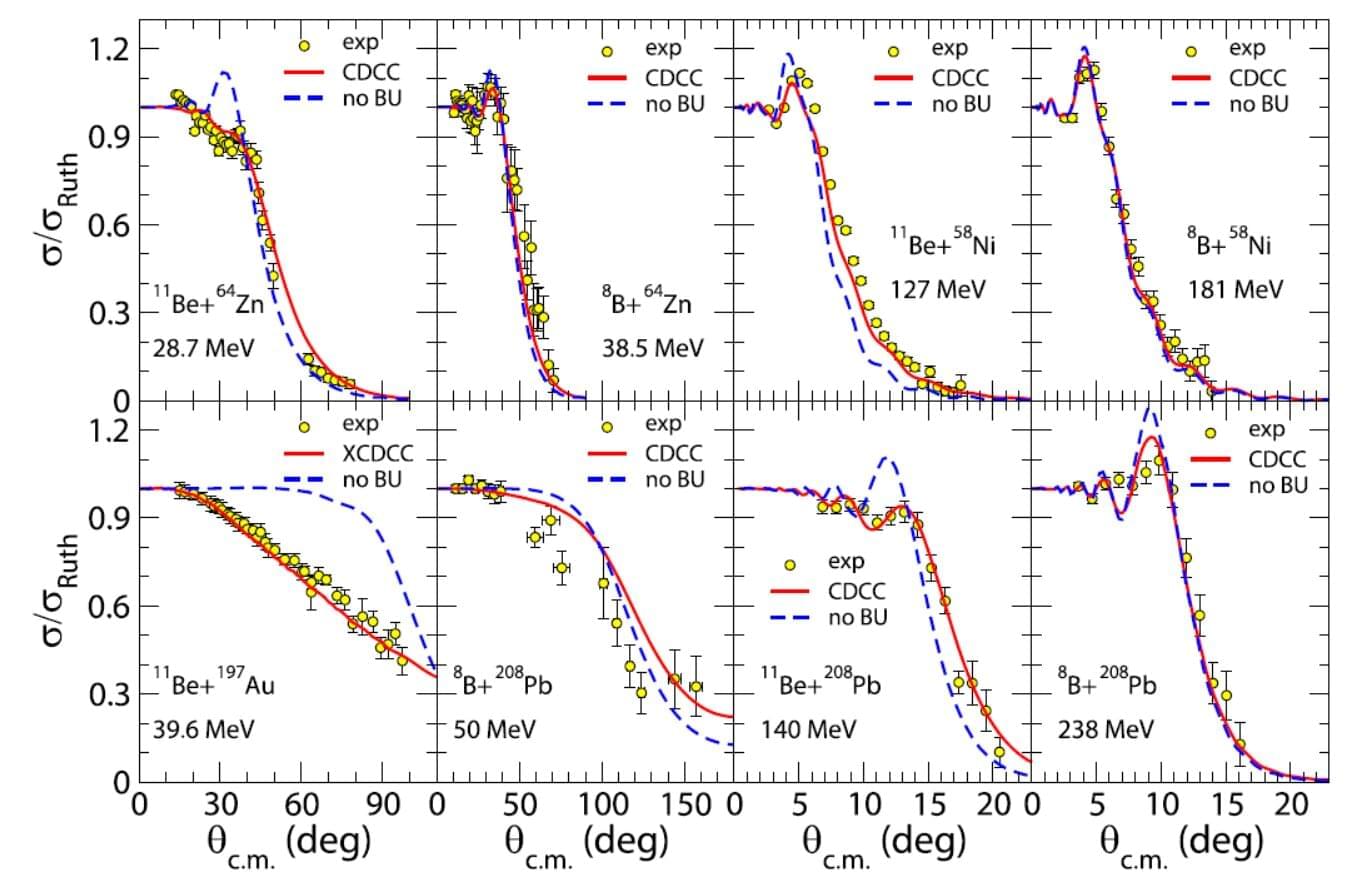China’s researchers stabilized a 100 MW microgrid, integrating a small modular reactor (SMR) and solar power.



Researchers from the Institute of Modern Physics (IMP) of the Chinese Academy of Sciences have reported new experimental results that advance our understanding of reaction dynamics and exotic nuclear structures of weakly bound nuclei.
The findings are published in Physics Letters B.
Weakly bound nuclei are characterized by their extremely low binding energy of protons and neutrons. Investigating their reaction mechanisms and exotic structures represents a frontier field in nuclear physics.

For decades, it’s been known that subtle chemical patterns exist in metal alloys, but researchers thought they were too minor to matter — or that they got erased during manufacturing. However, recent studies have shown that in laboratory settings, these patterns can change a metal’s properties, including its mechanical strength, durability, heat capacity, radiation tolerance, and more.
Now, researchers at MIT have found that these chemical patterns also exist in conventionally manufactured metals. The surprising finding revealed a new physical phenomenon that explains the persistent patterns.
In a paper published in Nature Communications today, the researchers describe how they tracked the patterns and discovered the physics that explains them. The authors also developed a simple model to predict chemical patterns in metals, and they show how engineers could use the model to tune the effect of such patterns on metallic properties, for use in aerospace, semiconductors, nuclear reactors, and more.


Nuclear fusion, which operates on the same principle that powers the sun, is expected to become a sustainable energy source for the future. To achieve fusion power generation, it is essential to confine plasma at temperatures exceeding one hundred million degrees using a magnetic field and to maintain this high-energy state stably.
A key factor in accomplishing this is the electric potential inside the plasma. This potential governs the transport of particles and energy within the plasma and plays a crucial role in establishing a state in which energy is effectively confined and prevented from escaping. Therefore, accurately measuring the internal plasma potential is essential for improving the performance of future fusion reactors.
A non-contact diagnostic technique called the heavy ion beam probe (HIBP) is used to measure plasma potential directly. In this method, negatively charged gold ions (Au⁻) are accelerated and injected into the plasma.

Nuclear physicists have developed a new theoretical framework that allows them to calculate a crucial quantity for understanding the three-dimensional movement of quarks inside a proton. Using this innovative method, researchers have created a far more precise picture of the quarks’ transverse motion, the movement that occurs around a proton’s spin axis and at right angles to its forward direction.
The latest calculations align closely with model-based reconstructions derived from particle collision data. They are especially effective for describing quarks with low transverse momentum, a region where older techniques lacked precision. Scientists plan to use this refined approach to better predict the full 3D behavior of quarks and the gluons that bind them in upcoming collider experiments.
Understanding the source of proton spin is one of the key scientific objectives of the upcoming Electron-Ion Collider (EIC). At this facility, collisions between spin-aligned protons and high-energy electrons will make it possible to measure the transverse motion of quarks and gluons within protons with remarkable accuracy.

Doug Philippone, co-founder of Snowpoint and former head of global defense at Palantir, will also join Valar’s board of directors.
Valar is one of several nuclear startups that hopes to benefit from President Trump’s push to deploy new reactor technology in the U.S. by cutting regulations and accelerating approvals.
Based outside Los Angeles, Valar is one of several reactor developers and states that are suing the Nuclear Regulatory Commission over its licensing process for small reactor designs. The parties to the suit are seeking a resolution with the NRC in the wake of Trump’s executive order that would overhaul the regulator. The case has been temporarily paused due to the government shutdown.

To study selection for somatic single nucleotide variants (SNVs) in tumor mtDNA, we identified somatic mtDNA variants across primary tumors from the GEL cohort (n = 14,106). The sheer magnitude of the sample size in this dataset, in conjunction with the high coverage depth of mtDNA reads (mean = 15,919×), enabled high-confidence identification of mtDNA variants to tumor heteroplasmies of 5%. In total, we identified 18,104 SNVs and 2,222 indels (Supplementary Table 1), consistent with previously reported estimates of approximately one somatic mutation in every two tumors1,2,3. The identified mutations exhibited a strand-specific mutation signature, with a predominant occurrence of CT mutations on the heavy strand and TC on the light strand in the non-control region that was reversed in the control region2 (Extended Data Fig. 1a, b). These mutations occur largely independently of known nuclear driver mutations, with the exception of a co-occurrence of TP53 mutation and mtDNA mutations in breast cancer (Q = 0.031, odds ratio (OR) = 1.43, chi-squared test) (Extended Data Fig. 2a and Supplementary Table 4).
Although the landscape of hotspot mutations in nuclear-DNA-encoded genes is relatively well described, a lack of statistical power has impeded an analogous, comprehensive analysis in mtDNA16,17. To do so, we applied a hotspot detection algorithm that identified mtDNA loci demonstrating a mutation burden in excess of the expected background mutational processes in mtDNA (Methods). In total, we recovered 138 unique statistically significant SNV hotspots (Q 0.05) across 21 tumor lineages (Fig. 1a, b and Supplementary Table 2) and seven indel hotspots occurring at homopolymeric sites in complex I genes, as previously described by our group (Extended Data Fig. 2b and Supplementary Table 3). SNV hotspots affected diverse genetic elements, including protein-coding genes (n = 96 hotspots, 12 of 13 distinct genes), tRNA genes (n = 8 hotspots, 6 of 22 distinct genes) and rRNA genes (n = 34 hotspots, 2 of 2 genes) (Fig. 1b, c, e).

President Trump said on Wednesday that he has instructed the Defense Department (DOD) to immediately begin testing U.S. nuclear weapons on an equal basis to China and Russia.
‘The United States has more Nuclear Weapons than any other country,’ Trump wrote. ‘This was accomplished, including a complete update and renovation of existing weapons, during my First Term in office. Because of the tremendous destructive power, I HATED to do it, but had no choice! Russia is second, and China is a distant third, but will be even within 5 years.’…
…Trump’s announcement on TruthSocial came shortly before he was slated to meet face-to-face with Chinese President Xi Jinping for the first time since 2019 in South Korea on Thursday.

Hyundai Engineering & Construction (Hyundai E&C) has taken a major step in expanding its global nuclear energy footprint.
On October 26, the company announced that it signed a basic design contract with Fermi America, a U.S.-based energy development firm, for the construction of four large nuclear reactors in Texas. The project will form part of what is expected to be the world’s largest integrated energy and artificial intelligence (AI) campus.